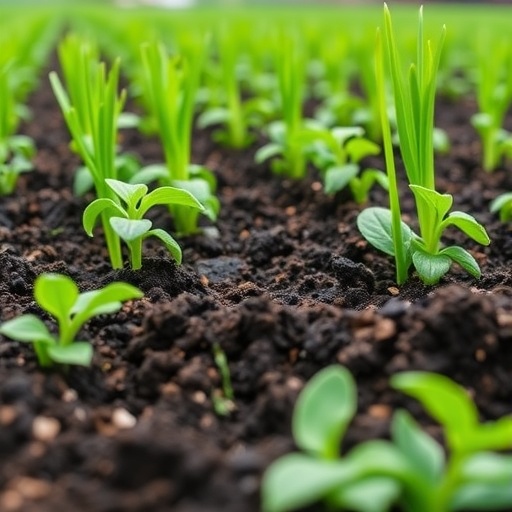A groundbreaking study from Bangor University offers a promising strategy to tackle two of agriculture’s most pressing challenges: reducing greenhouse gas emissions and sustaining crop productivity on peat soils. Researchers have revealed that combining water table management with biochar—a carbon-rich soil amendment derived from plant biomass—can significantly limit harmful emissions from agricultural peatlands, all while boosting crop yields. This innovative approach, detailed in a 2025 publication in the journal Biochar, marks a watershed moment in climate-smart farming.
Peat soils are among the world’s most fertile, supporting high crop productivity. However, these soils have a dark side: when drained for conventional farming, they release large amounts of greenhouse gases—carbon dioxide (CO₂), methane (CH₄), and nitrous oxide (N₂O)—fueling global warming. Additionally, peat decomposition leads to soil subsidence and carbon loss, undermining long-term soil health. The Bangor University team, led by Dr. Peduruhewa H. Jeewani, tackled this paradox by investigating whether elevating the water table coupled with biochar application could mitigate emissions without compromising productivity.
Through rigorous experimental trials, the team demonstrated that raising the water table—the level below which the soil is saturated with water—reduces oxygen availability in peat, thereby slowing microbial oxidation of organic matter. This water level adjustment was found to decrease CO₂ emissions by 18 percent and nitrous oxide emissions by 40 percent. Although a slight increase in methane emissions was observed, the overall greenhouse gas footprint was substantially reduced when considered in carbon dioxide equivalent terms.
The study’s innovation lay in integrating biochar application with rewetting strategies. Biochar’s porous structure and stability make it an exceptional soil conditioner with a myriad of environmental benefits. When introduced into peat soils under wetter conditions, biochar further curbed greenhouse gas emissions, reducing total emissions by as much as 4.64 tonnes of CO₂ equivalents per hectare annually. This synergistic effect suggests that biochar not only adsorbs gases but also influences soil biogeochemical processes, offering a dual function in climate mitigation.
A notable outcome was the marked enhancement in crop performance on biochar-treated peat. Lettuce plants grown in these amended soils exhibited biomass increases between 38 to 56 percent compared to untreated controls, regardless of water table levels. This improvement indicates biochar’s role in optimizing soil nutrient availability and water retention, which are critical in sustaining crop growth in variable moisture conditions typical of peatlands.
The researchers delved deeper into the soil microbiome, uncovering shifts in fungal populations linked to biochar application. The abundance of peat-decomposing fungi such as Ascomycota diminished notably, which likely contributed to lower carbon release from organic matter decomposition. Simultaneously, microbial diversity increased, fostering a soil ecosystem more conducive to nutrient cycling and plant health. These microbiome alterations underscore biochar’s potential as a biological modulator that stabilizes soil carbon and promotes productive symbiotic relationships.
Dr. Jeewani emphasized the potential of this integrated soil management practice to reconcile the often competing goals of food security and climate mitigation. “Our findings demonstrate that it is possible to break the conventional trade-offs by combining physical water management with biochar amendments, enabling sustainable intensification on vulnerable peat landscapes,” she noted. This approach offers farmers a climate-smart toolkit that maintains profitability while reducing their carbon footprint.
Europe stands to gain significantly from these insights, as peatlands account for substantial portions of the continent’s agricultural land and carbon emissions. Globally, drained peat soils contribute approximately four gigatonnes of CO₂ equivalents annually. The study’s demonstration that rewetting combined with biochar amendments can safeguard soil carbon stocks while enhancing yields aligns with broader climate neutrality goals and sustainable land management policies.
The experimental design implemented by Bangor University involved detailed gas flux measurements paired with crop growth assessments and molecular analyses of soil microbial communities. This interdisciplinary approach provided comprehensive evidence linking management interventions to ecological outcomes. The findings underscore the value of combining agronomic techniques with cutting-edge soil science to design systems that are both productive and environmentally responsible.
Biochar’s influence on biogeochemical cycling extends beyond greenhouse gas mitigation. By stabilizing organic matter, retaining nutrients, and modifying microbial processes, biochar application fosters enhanced soil fertility and resilience against climatic stresses. In peat soils, where organic carbon stability is paramount, introducing biochar could serve as a long-term carbon sequestration strategy, complementing rewetting efforts that slow organic matter oxidation.
The study also highlights the nuanced relationship between water table management and methane emissions. While methane release did increase slightly under raised water tables—owing to anaerobic conditions favorable to methanogenic microbes—the overall net greenhouse gas emissions declined due to more pronounced reductions in CO₂ and N₂O. This finding points to the importance of evaluating multi-gas dynamics in peat soil management and tailoring interventions to optimize net climate benefits.
The broader implications of the research extend to global strategies for combating climate change within agriculture, a sector responsible for a significant share of anthropogenic emissions. Implementing wetter farming techniques with biochar amendments offers a scalable pathway to transform peatland agriculture from a carbon source to a carbon sink, contributing to international commitments under frameworks such as the Paris Agreement.
As the pressure mounts on global food systems to be both productive and sustainable, this study illuminates a practical and scientifically grounded method to meet these dual challenges. The integration of hydrological management with biochar application exemplifies innovative, nature-based climate solutions emanating from robust experimental science. In the context of escalating climate change and land degradation, such advances provide vital strategies for resilient and regenerative agriculture.
In conclusion, raising the water table in concert with biochar soil amendments represents a remarkable advance in managing agricultural peatlands. This dual intervention not only reduces critical greenhouse gas emissions but also fosters greater crop productivity and soil biodiversity. Future policies encouraging the adoption of such methods could reshape peatland agriculture, helping to mitigate climate change while securing food production sustainably.
Subject of Research: Not applicable
Article Title: Wetter farming: raising water table and biochar for reduced GHG emissions while maintaining crop productivity in agricultural peatlands
News Publication Date: September 15, 2025
Web References: DOI link
References: Jeewani, P.H., Agbomedarho, E.O., Evans, C.D. et al. Wetter farming: raising water table and biochar for reduced GHG emissions while maintaining crop productivity in agricultural peatlands. Biochar 7, 110 (2025).
Image Credits: Peduruhewa H. Jeewani, Emmanuella Oghenefejiro Agbomedarho, Chris D. Evans, David R. Chadwick & Davey L. Jones
Keywords
Agriculture, Biofuels, Environmental sciences, Environmental chemistry, Organic farming, Refuse derived fuels
Tags: agricultural productivity on peatlandsbiochar application in agriculturecarbon-rich soil amendmentsclimate-smart agriculture solutionsemissions reduction in agricultureenhancing crop yields with biocharinnovative farming techniques for soil healthmitigating climate change in farmingpeat soil management strategiesreducing greenhouse gas emissionssustainable farming practiceswater table management techniques






